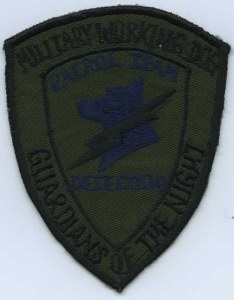I'm fascinated by dogs performing work duties, be it something they were bred for (Border Collies herding sheep), or something they were taught to do (Dobermans as Service Dogs). A dog performing work that he or she loves is a beautiful thing to watch, and a good dog-human partnership is a well-oiled machine.
Military Working Dogs fall into this category, of course. In fact, there are around 2, 300 dogs currently deployed by the U.S. Military to perform a number of tasks with our troops.
I got the above photograph off of the Wikipedia "Dogs in Warfare" article because, well, I don't have any of my own. Their description is:
U.S. Army Staff Sgt. Kevin Reese and his military working dog Grek wait at a safe house before conducting an assault against insurgents in Buhriz, Iraq, April 10, 2007. U.S. Army Soldiers from 5th Battalion, 20th Infantry Regiment, 2nd Infantry Division and Iraqi army soldiers from 4th Battalion, 2nd Brigade, 5th Iraqi Army Division are going house-to-house in search for weapons caches and enemy fighters after more than 1,000 residents of this Baqubah suburb were displaced by Al-Qaeda insurgents. (U.S.Air Force photo by Staff Sgt. Stacy L. Pearsall) www.army.mil
So, that quote tells you a little bit about what dogs in the military do. Some of them are trained for detection, be it explosives, arms, or ammunition. If a MWD (military working dog) can find a weapons cache, or an IED (improvised explosives device), the number of lives saved cannot be counted. IEDs have been, I think, one of the top causes of troop deaths in the currently ongoing conflict.
Dogs are also used both on guard duty and on patrol. A dog, visually, is a very obvious deterrent. I am no privy to the specific training that currently goes into U.S. Military dogs, but I can speculate that it must be similar to Schutzhund; an obedience portion and a protection portion, with tracking and detection added depending on what the dog is supposed to be doing. Currently, the only U.S. facility where MWD's are trained is Lackland Air Force Base, in Texas: Department of Defense Military Working Dog School.
U.S. Air Force military working dog Jackson sits on a U.S. Army M2A3 Bradley Fighting Vehicle before heading out on a mission in Kahn Bani Sahd, Iraq, Feb. 13, 2007. His handler is Tech. Sgt. Harvey Holt, of the 732nd Expeditionary Security Forces Squadron.
Military Working Dogs were in the spotlight a few months ago, when Osama Bin Laden was killed, and it was leaked that one of the Seal Team members was a dog named Cairo. Being the crazy person that I am, I immediately zeroed in on the fact that a dog was involved on the operation, and wondered what Cairo's specific function was. Did they train him to track Bin Laden, so they could find him in the compound? Was he general support and deterrent? According to an article in The New Yorker, "Cairo’s role was to help clear the buildings, sniff for bombs and booby-traps, search for false walls or hidden doors where Bin Laden could be hiding, or help keep curious neighbors at bay."
Although the U.S. Military used Dobermans during World War II in the Pacific Theatre, the German Shepherd and the Belgian Malinois (like Cairo) are more popular as MWD's. Every dog trainer, and perhaps many military personnel, have their opinions on what dog breeds are suitable for what jobs, and why. In these situation, successful training for the Doberman may or may not need to be different from that of the German Shepherd or the Malinois, as described in the article Why Dobermans are Different, by John Soares. Another good web site for information is uswardogs.org, and you can also see petitions there for commemorative War Dog stamps, and donations for a U.S. War Dog monument.
So, I'm writing about MWD's for a couple of reasons. First, it's because I think they're really cool. The other reason is because it's very expensive to outfit Military Working Dogs, and without donations from the public, they might not receive the things that they need. For example, cooling vests have been crucial for their well being in operations in Iraq and Afghanistan, and they don't necessarily come outfitted with them. Cooling Vests can be donated through Helping Udders. There's another web site, http://www.supportmilitaryworkingdogs.org/, that outfits MWD's with things like Doggles, to keep the grit out of their eyes to protect them from the sun, and MuttLuks, which are boots that protect their paws. More information about how they got started and what they sent in a completed package is here. It costs about $400, per dog.
Military Working Dogs Guardians of the Night, by Linda Crippen




Marine General Puller got into a controversy because he didn't want Dobies in combat. He claimed they were too sensitive to concussion.
ReplyDeleteIn the book Marine!The Life of Chesty Puller, the author recounted an encounter with an official of a Doberman breeding association, who got very indignant over Puller's claims.
Anyway, I hope that Dobie lovers can be realistic about breed problems, and maybe correct them.
Just another item of curiousity: a Dobie owner told me he gave his pooch an aspirin daily. Supposedly a vet said their skulls were too narrow, and caused headaches from brain pressure.
Interesting stuff, thanks for commenting! I'll see if I can lay my hands on a copy of that book.
ReplyDeleteThere's at least one breed I know of that has a skull that's malformed for its brain in many cases, causing pain for the dog.....and it's the Cavalier King Charles Spaniel. Not the Doberman. Shame on that vet!